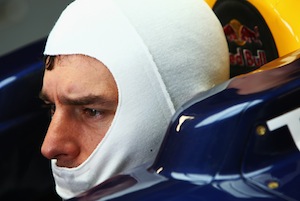'Welcome back': Reliving the last Chinese Grand Prix ahead of its much-anticipated return five years later
Five-years is a long time in motorsport, let alone the general state of the world – especially given the impact of the Covid-19 pandemic…

Mark Webber survived a horror crash at the European Formula One Grand Prix at the Valencia Street Circuit.
Mark Webber will make headlines and newsreels around the world today, but for all the wrong reasons. Webber survived one of the most terrifying accidents in recent Formula 1 history at last night’s European Grand Prix on the streets of Valencia.
Following a poor start and an early pitstop, Webber was fighting his way through the field when he came up to the back of Heikki Kovalainen’s Lotus.
As Webber closed in on Kovalainen, the Finn appeared to brake earlier than the Aussie expected. Webber made contact with the right rear wheel of the Lotus, sending him into the air, hitting an advertising board, somersaulting and careering into the tyre barriers at high speed (see the accident in the video below).
Who was to blame?
Webber definitely pushed his luck by waiting in the slipstream of the Lotus for so long, knowing it’s well off the pace of the leading contenders.
But considering this Kovalainen shouldn’t have been aggressively defending his line or, as some believe, should have been less indecisive in picking a line to give Webber some room.
As Webber acknowledged post-race, both were in the wrong to an extent.
“Well, it always takes two to tango, doesn’t it? There’s two of us in this incident,” Webber told the BBC.
“I’ve driven slow cars – I’ve been at the back – and obviously when someone comes up with those kind of closing distances to be down the inside, bouncing off the limiter and carrying on like it is going to.
“I mean how long is that [staying ahead] going to last for? It’s going to last another 15 seconds so is it worth it?”
While Lotus team chief Mike Gascoyne defended his driver by saying he has a right to race, the reality is the new teams, such as Lotus, have been woefully off the pace all season (not their fault considering the mountain they faced when the proposed budget cap never materialised) and this type of accident was always on the cards.
Knowing this Kovalainen should have relented, and Webber been more circumspect.
However, this type of accident can happen at any time in open wheel racing, and it is worryingly becoming more frequent as drivers weave and block to protect position, with the stewards rarely punishing such behaviour.
Ironically there was a similar accident in the feeder GP2 category earlier in the day.
It’s motorsport’s worst nightmare when cars become airborne, and it’s not so much a car crash but more like a plane crash as the unstoppable missile flies through the air.
At Le Mans in 1955, around 87 fans were killed (much more injured) when a Mercedes sportscar was sent hurtling into the main grandstand.
Also at Le Mans, in 1999, the Mercedes factory team, with Webber ironically in the squad, suffered multiple spectacular flips.
At Queensland Raceway during this year’s V8 Supercar round, an out of control Mini rolled into the crowd, thankfully without causing any serious injuries.
Had Webber made contact with the fence in the air at such speed, it could have been very ugly.
While F1 drivers are cocooned in their cockpits, contact at that speed and at an angle where the drivers’ heads could be making the initial contact with the fence or worse almost always results in serious injury or death. When a car is airborne there is obviously no chance for the driver to brake so there is no way for the car to dissipate its speed and energy without hitting something.
We’ve seen such accidents in IndyCars, from Kenny Brack’s awful accident that ended his career, to Aussie Ryan Briscoe’s wild ride, to Jeff Krosnoff’s fatal accident.
The latter also killed a marshal, as did Jacques Villeneuve’s huge crash at the 2001 Australian Grand Prix, and motorsport must be vigilant to ensure spectators, officials and marshals are protected as best as possible.
While drivers make the choice to take the risks involved in competing in motorsport and are rewarded handsomely for taking those gambles, the fans and spectators shouldn’t be exposed to such risks.
As Sir Jackie Stewart has said previously, should motorsport suffer a similar accident to the Le Mans 1955 disaster it risks being ostracised.
Both the sport at large and Webber should consider themselves very lucky for they survived another close call.
Mark Webber Crash Video: